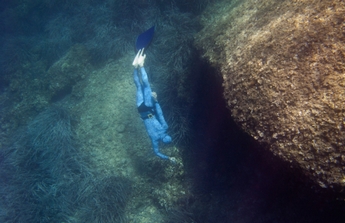|
Kimberlite
Kimberlite is a volcanic rock made of potassium minerals which usually contain diamonds. Kimberley, South Africa is the town this volcanic rock is named for after an 83.5 carats (16.7g) diamond was discovered in 1871. The discovery gave rise to a diamond rush, which later created the Big Hole, an open-pit mine in Kimberley. Its considered to be the largest hole excavated by hand. In the Earth's crust this volcanic rock is found in vertical structures known as kimberlite pipes. These pipes are the most important source of mined diamonds. These rocks are formed deep within the mantle, between 150 and 450 kilometres deep. They are from abnormal enriched mantle compositions, which erupts rapidly and violently, usually with considerable carbon dioxide and other volatile elements.
City of Diamonds These pipes are carriers of diamonds, garnets peridotite ( a dense, coarse-grained igneous rock), and mantle xenoliths (a rock fragment) to the Earth's surface. Its derivation from the depths are greater than any igneous rock type, and the extreme magma composition reflects low silica content and high levels of other enriched trace elements that make kimberlite understandably important for further studies on the composition of the deep mantle.
Kimberlite Core Alluvials are areas where some diamonds are found such as in ocean floors and river beds. It is where you'll find gold and diamond explorations. Knowledge of this complex subsurface geological environment is critical for resource explorations, project economics and mine engineering. Some miners do explorations to find diamonds, most projects are costly and financed by major diamond corporations. Other miners use the more simple methods for finding diamonds, such as digging using shovels and sifting through mud, gravel, and sand with their bare hands in a large round flat-shaped pan.
Diamond Mining Boats Diamonds are mostly found in geologic rock formations called kimberlites. These rock formations are eroded over time by rivers and streams. Diamonds are deposited in sediments which are carried by streams farther downstream from the original place of the rock formations. The small-scale miners use a diamond mining technique to mine sediments in alluvials called Artisanal Mining. These miners use simple tools and equipment in the informal sector, outside the legal regulatory framework.
A Dark Tunnel With Water Ocean floors and river beds are the other alluvial areas where diamonds are found. Ocean diamond mining is not commercially viable for industrial diamonds yet. However, diamonds in the ocean floor are hunted for and mined in the alluvial areas offshore of the southern tip of Africa and in the Indonesian waters. Only a small fraction of the world's total production of diamonds from the ocean, become fashion jewelry for consumers.
Danube River The fluvial process of eroded diamonds from the river drainage system only produce 10 per cent of gem quality stones that end up deposited on land. Whereas, 90 per cent of these diamonds are still on the ocean or sea floor. They are concentrated into diamondiferous gravels for an indefinitely long period of time of current and wave action.
Free Diver Descent When these stones survive the journey to the coast, they are mostly of superior color, clarity, and sizes that interest consumers in the retail jewelry industry. These African offshore diamonds usually range from 0.2 to 20 carats in size.
Free Diver Checking Out Underwater Rocks From Kimberlite Back To Diamond Mines
|












